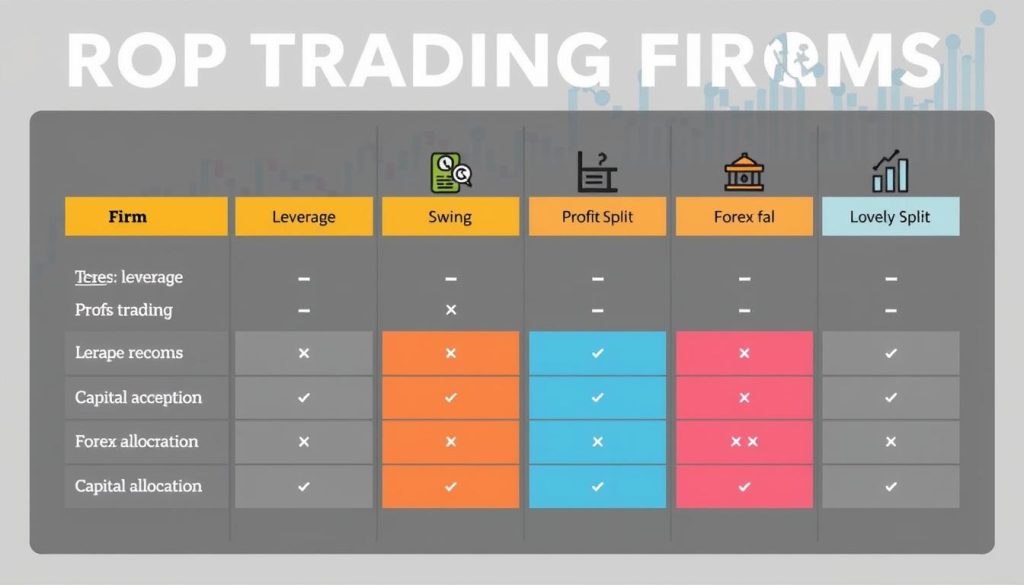How to Pass a Prop Firm Evaluation: Complete Guide
Entering the world of prop trading is both thrilling and demanding. Getting a funded trading account through a proprietary trading firm evaluation is key. This guide will give you the knowledge and strategies to ace a prop firm evaluation. It’s your first step to becoming a funded trader.

Key Takeaways
- Understand the importance of prop firm evaluations and how they can launch your trading career
- Discover the different types of prop firm challenges and the requirements to excel in each
- Learn effective risk management techniques and position sizing methods to navigate the evaluation process
- Identify and avoid common trading mistakes that can hinder your success during the evaluation
- Explore the benefits of choosing the right prop firm that aligns with your trading style and goals
Understanding Prop Firm Evaluations and Their Importance
In the trading world, proprietary trading firms, or “prop firms,” are gaining popularity. These firms let traders use big trading capital and get help from professionals. This way, traders don’t risk their own money.
What is a Proprietary Trading Firm?
A proprietary trading firm uses its own money to trade things like stocks and currencies. They have a team of skilled traders. These traders use different strategies and tools to find and make money from market chances.
Types of Prop Firm Evaluations
- Live Account Evaluation: Traders get a funded account to trade with the firm’s money. They aim to show they can make consistent profits.
- Simulated Account Evaluation: Traders trade on a fake platform. This lets the firm check their skills and decisions without risking real trading capital.
Why Traders Choose Prop Firms
Traders like prop firms for many reasons, including:
- Access to Big Trading Capital: Prop firms let traders use more money than they could on their own. This means they can make more money.
- Professional Resources and Mentorship: Prop firms offer training, coaching, and mentorship. This helps traders get better and make successful strategies.
- Risk Mitigation: Trading with the firm’s money means traders don’t risk their own money. This is good for new traders.
Understanding proprietary trading firms and their evaluations is key for traders wanting to start in professional trading. Prop firms offer many benefits.
Step-by-Step Guide to Passing a Prop Firm Evaluation
Getting through the evaluation process with a prop firm is a big step for traders. It’s key to have a solid plan to tackle this trading challenge. This guide will give you the tools and success strategies to do well in your prop firm evaluation process.
Start by getting ready thoroughly. Learn all about the prop firm rules and what they expect from you. Knowing the trading rules, risk management, and how they measure performance will help you show your skills.
- Make a detailed trading plan that fits the prop firm’s needs. Use risk management, position sizing, and entry/exit rules to show your disciplined trading.
- Practice your strategies in a simulated environment. This will help you improve and find areas to get better. Keep records of your trades and analyze them to refine your strategy.
- Make sure your trading setup is ready for the evaluation. Test everything to avoid any technical problems during the live trading challenge.
Stay focused on your trading plan and risk management during the evaluation. Follow the prop firm’s rules to show you can trade well. Stay calm and make smart decisions based on your strategies.
| Key Factors for Prop Firm Evaluation Success | Description |
|---|---|
| Risk Management | Show you can manage risk well, following the firm’s rules. |
| Consistent Profitability | Keep making profits consistently, as the firm requires. |
| Disciplined Execution | Trade with precision and discipline, showing your skills. |
After the evaluation, look over your performance carefully. See what worked and what didn’t. Make changes to get better. Always keep learning and reflecting on your trading to do well in the long run.

By following this guide, you’ll be ready for the prop firm evaluation. You’ll have a better chance at a great trading opportunity. Be ready for the challenge, stay disciplined, and show off your trading skills.
Common Rules and Requirements for Prop Firm Challenges
Aspiring traders face a tough test to join a proprietary trading firm. This test, called a “prop firm challenge,” checks their risk management, profit goals, and trading rules. Knowing the rules set by prop firms is key to passing these tests and getting a job.
Maximum Daily Loss Limits
Prop firms have a rule on the maximum daily loss a trader can have. This limit is strict and helps protect the firm’s money. It also keeps the trader’s risk-taking in check.
Overall Profit Targets
Prop firms also set profit goals for traders to meet. These profit targets help the firm see if a trader can make money consistently. It shows if the trader fits the firm’s goals.
Trading Time Restrictions
Another rule is about when traders can trade. These trading time restrictions limit when trades can be made. It makes sure the test is fair and the trader meets the firm’s standards.
| Evaluation Criteria | Prop Firm Requirements |
|---|---|
| Maximum Daily Loss Limit | $500 |
| Overall Profit Target | $5,000 |
| Trading Time Restrictions | Monday-Friday, 9 AM to 4 PM EST |
By following these rules, traders can boost their chances of passing a prop firm challenge. This can lead to a job in a proprietary trading firm.
Essential Trading Psychology for Evaluation Success
Doing well in prop firm evaluations is not just about knowing how to trade. You also need to be mentally prepared, control your emotions, and have a disciplined mindset. These skills are key to performing well under stress. By focusing on the psychological side of trading, you can boost your chances of passing these tough tests.
Cultivating a Winning Mindset
Having a positive and strong trading mindset is vital for overcoming prop firm evaluation challenges. This means:
- Seeing setbacks as chances to learn and get better.
- Using mental preparation like visualization and affirmations to stay confident and focused.
- Being committed to always learning and improving your skills.
Mastering Emotional Control
Emotions can be a big problem for traders during evaluations. It’s important to have strong emotional control to stay consistent:
- Use stress management like deep breathing and meditation to stay calm.
- Learn to quickly handle your emotions so they don’t affect your decisions.
- Stay disciplined and follow your trading plan, even when it’s hard.
“Successful trading is 20% strategy and 80% mindset.” – Market Guru
By working on your trading mindset, mastering emotional control, and being disciplined, you can succeed in prop firm evaluations and more.

| Psychological Aspect | Importance for Prop Firm Evaluations |
|---|---|
| Mental Preparation | Builds confidence, focus, and resilience to perform under pressure |
| Emotional Control | Prevents emotional volatility from disrupting decision-making and trading performance |
| Discipline | Ensures adherence to trading plans and strategies, even in challenging market conditions |
Next step is to learn how to scale your trading after passing a prop firm evaluation
Developing a Winning Trading Strategy for Evaluations
Creating a winning trading strategy is key for prop firm evaluations. It’s about finding the right mix of risk management, position sizing, and clear entry and exit rules. Mastering these areas can help traders ace the evaluation.
Risk Management Techniques
Good risk management is the base of a profitable trading plan. Prop firms look closely at how well traders manage risk. It’s vital to use strong techniques like:
- Setting right stop-loss levels to cap losses
- Diversifying to spread out risk
- Using a consistent risk-reward ratio for good trades
Position Sizing Methods
Right position sizing is key for managing risk and making the most of returns in prop firm evaluations. Traders should try different methods, such as:
- Fixed fraction sizing: Using a set percentage of account capital for each trade
- Risk-based sizing: Adjusting trade size based on risk
- Volatility-based sizing: Scaling trade size with market volatility
Entry and Exit Rules
Having clear entry and exit rules is vital for steady trading. Prop firms check how well traders spot good trade setups and manage them. Consider using:
- Clear technical and fundamental triggers for entering trades
- Set profit targets and stop-loss levels for trade management
- Ways to handle and reduce potential losses
By adding these key elements to your trading plan, you can create a detailed and strategy optimization. This will boost your chances of passing the prop firm trade management evaluation.

Top Trading Mistakes to Avoid During Evaluation
Going through a proprietary trading firm (prop firm) evaluation can be tough. It’s filled with mistakes that can stop even the best traders. Knowing the common errors helps you get ready for success. Let’s look at the top mistakes to avoid during your prop firm evaluation.
- Overtrading: Many traders struggle with overtrading during evaluations. The need to do well can make them act too quickly. This can lead to too many trades and higher risks. It’s key to focus on making good trades, not just a lot of them.
- Emotional Trading: Evaluations can be stressful, and emotional decisions can hurt your score. It’s important to control your feelings, like fear and greed. Staying calm and thinking clearly is vital for success.
- Risk Management Failures: Not managing risks well can cause big losses. Traders need a solid plan for managing risks, like knowing when to stop and diversifying. Ignoring these basics can lead to big failures.
- Common Errors: Traders should also watch out for other mistakes, like bad trade execution and not doing market analysis. These errors can add up and hurt your chances of success.
By avoiding these common mistakes, traders can boost their chances of passing the evaluation. This can lead to a spot in a top proprietary trading firm.
“Successful trading is about managing risk, not maximizing returns.” – Anonymous
Best Practices for Money Management in Prop Trading
Effective money management is key to success in prop trading. It involves keeping capital safe, controlling risks, and managing drawdowns. These skills help traders pass evaluations and build lasting careers.
Calculating Position Sizes
Finding the right position size is vital for risk management. Traders should use position sizing methods that fit their strategy and risk level. This might mean using a fixed percentage of capital or adjusting sizes based on market conditions.
Managing Drawdowns
Drawdowns are a part of trading. Having a solid drawdown management plan is essential. This includes setting loss limits, diversifying strategies, and using strong risk controls to reduce drawdown impacts.
Setting Stop Losses
Protecting capital is crucial, and stop losses are key. Traders must analyze market conditions and trade risks to set stop-loss levels. Regular use of stop losses helps keep capital safe and supports capital preservation during evaluations.
By following these best practices for money management, prop traders can face evaluation challenges with confidence. This boosts their success chances and helps build a strong trading career.

Choosing the Right Prop Firm for Your Trading Style
Finding the right prop firm is key to your trading success. There are many prop firm comparison models, account types, and trading conditions to choose from. Knowing your trading style and goals helps you find the best fit.
Look at the evaluation model of the prop firm. Some focus on profit, while others on risk and consistency. Check if their rules match your trading style. Prop firms also offer different account sizes, from small to large. Think about the risk and your financial goals to pick the right one.
Also, consider the trading conditions of the prop firm. This includes leverage, order execution, and trading tools. Make sure the firm’s setup supports your trading style and helps you succeed.
| Prop Firm | Evaluation Model | Account Types | Trading Conditions |
|---|---|---|---|
| Prop Firm A | Profit-based | $25,000, $50,000 | Leverage up to 1:100, Low Commissions |
| Prop Firm B | Risk-based | $100,000, $200,000 | Leverage up to 1:50, High-Speed Execution |
| Prop Firm C | Hybrid (Profit & Risk) | $75,000, $150,000 | Leverage up to 1:75, Advanced Trading Tools |
By carefully looking at these factors and matching them with your trading style and goals, you can choose the right prop firm. This will help you get the best trading conditions and evaluation models for success.

Technical Analysis Tools for Evaluation Trading
Technical analysis tools are crucial in the world of prop firm evaluations. They help traders gain an edge by spotting key chart patterns and using important trading indicators. Knowing these tools well can make a big difference in passing or failing the evaluation challenge.
Essential Chart Patterns
Learning to recognize chart patterns is key for traders aiming to succeed in prop firm evaluations. It’s important to know about patterns like the head and shoulders, double tops and bottoms, and triangles. Understanding these chart patterns helps predict market movements and make smart trading choices.
Key Technical Indicators
Technical indicators provide a lot of useful information for trading during evaluations. Tools like moving averages, the Relative Strength Index (RSI), and the Stochastic Oscillator show trends, momentum, and when prices might be too high or too low. Using these indicators can help time your trades better.
Price Action Strategies
Studying price action is a strong technique for understanding market behavior without just looking at indicators. By looking at candlestick patterns, support and resistance levels, and other price signals, you can get a deeper understanding of the market. This helps make better trading choices during evaluations.
Getting good at these technical analysis tools and techniques can really help in prop firm evaluations. By knowing how to spot chart patterns, use indicators, and understand price action, you can make better trading decisions. This can increase your chances of passing the evaluation with success.

| Technical Analysis Tool | Key Benefits |
|---|---|
| Chart Patterns | Identify market trends and potential price reversals |
| Technical Indicators | Assess market momentum, overbought/oversold conditions, and more |
| Price Action Strategies | Understand market psychology and make more informed trading decisions |
“Mastering technical analysis is not just about recognizing patterns and indicators, but also about developing the ability to interpret market behavior and make informed trading decisions.”
Creating a Pre-Trading Checklist for Evaluations
Passing a prop firm evaluation needs careful trading preparation and a steady routine. A detailed pre-trading checklist is a great way to boost your performance. It helps keep you consistent and improves your trading skills during the evaluation.
Here are some important things to add to your pre-trading checklist for prop firm evaluations:
- Review your trading plan and strategy: Make sure your trading plan fits the prop firm’s rules and risk levels.
- Check your market analysis: Look at the latest market trends, economic news, and any news that might affect your trades.
- Verify your trading tools and platform: Make sure your trading tools and platform are set up right and working well.
- Assess your mental state: Take a moment to check if you’re emotionally ready to trade. Are you focused and calm?
- Review your position sizing and risk management: Double-check that your risk management and position sizing match your plan and the prop firm’s rules.
- Prepare your trading journal: Look over your past trading journal entries and update them to improve your trading preparation and routine development.
By making and sticking to a pre-trading checklist, you can optimize your trading performance and show the prop firm your consistency. This increases your chances of passing the evaluation.
“Consistency is the key to success in prop firm evaluations. A well-developed pre-trading checklist can help you maintain that consistency throughout the challenge.”

| Element | Purpose |
|---|---|
| Trading Plan Review | Ensures alignment with prop firm requirements |
| Market Analysis | Informs trading decisions and risk management |
| Trading Tools Check | Verifies proper setup and functionality |
| Mental Readiness Assessment | Evaluates emotional and psychological state |
| Risk Management Review | Confirms adherence to prop firm’s rules |
| Trading Journal Update | Refines trading preparation and routine development |
Real-Time Market Analysis During Evaluations
Dealing with the fast-changing financial markets during a prop firm evaluation can be tough. But, learning how to analyze the market in real-time can really help. By watching market sentiment, keeping up with news, and studying trading volume, you can make smart choices. These choices can be the difference between success and failure.
Assessing Market Sentiment
Understanding market sentiment is key to predicting price changes and adjusting your strategy. Look for signs like investor fear or greed. Also, check the VIX (Volatility Index) to see how the market feels. This helps you spot market changes and jump on new trends.
Leveraging News Impact Trading
In the quick world of prop firm evaluations, news can greatly affect prices. Learn to spot news that moves the market and trade on it. Watch for economic news, world events, and news specific to your industry. This way, you can stay ahead of others.
Analyzing Trading Volume
Trading volume shows how active the market is and can hint at price trends. Keep an eye on volume changes. They can show shifts in market mood and possible price moves. Use volume analysis in your trading plan to make better choices during evaluations.
| Technique | Description | Benefits |
|---|---|---|
| Market Sentiment Analysis | Assessing investor fear, greed, and overall market mood | Identify market turning points and capitalize on emerging trends |
| News Impact Trading | Monitoring and trading based on market-moving news events | Gain an edge over the competition and respond quickly to new information |
| Volume Analysis | Closely monitoring changes in trading volume to identify potential price trends or reversals | Make more informed trading decisions during the evaluation process |
Using these real-time market analysis methods in your prop firm evaluation strategy can boost your success chances. It shows your trading skills to the evaluators. Remember, keeping up with market mood, news, and volume is crucial for handling evaluation challenges.
Conclusion
Passing a prop firm evaluation needs a smart plan, strict discipline, and a good grasp of trading. You’ve learned the key rules, a winning strategy, and how to manage your mind. This puts you on the path to evaluation success and becoming a funded trader.
This guide has given you the tools to tackle the tough prop firm opportunities. It’s time to use what you’ve learned to grow your trading career. Keep being consistent, manage risks well, and stay dedicated to your craft. This is how you succeed in prop trading.
Now, it’s time to apply what you’ve learned. Use the lessons to improve your trading plan. Be brave and face the prop firm evaluation challenges head-on. With hard work and a drive for excellence, you’ll achieve your trading career goals.
FAQ
What is a Proprietary Trading Firm?
A proprietary trading firm, or prop firm, trades with its own money. It doesn’t use client funds. These firms offer trading chances and capital to new traders. They earn a share of the profits.
What types of Prop Firm Evaluations are there?
Prop firms use different ways to test traders. They have trading challenges, simulated accounts, and live accounts. Each test has its own rules and goals for traders.
Why do Traders choose to join Prop Firms?
Traders join prop firms for big trading capital and professional help. They get to earn from profits without using their own money. It’s a chance to grow their skills and get funded.
What are the typical Rules and Requirements for Prop Firm Challenges?
Challenges have rules like daily loss limits and profit goals. Traders must follow these to pass and get funded.
How can Traders develop a Winning Trading Strategy for Prop Firm Evaluations?
A winning strategy involves good risk management and clear rules. It should aim to make profits while keeping losses low.
What are the Top Trading Mistakes to Avoid During Prop Firm Evaluations?
Traders should avoid overtrading, emotional decisions, and ignoring risk rules. These mistakes can hurt their chances of success.
What are the Best Practices for Money Management in Prop Trading?
Good money management means right position sizes and managing losses. It’s key for keeping capital safe during evaluations.
How can Traders choose the Right Prop Firm for their Trading Style?
Traders should look at the evaluation model and trading conditions. They should find a firm that fits their style and goals.
What Technical Analysis Tools are Useful for Prop Firm Evaluation Trading?
Useful tools include chart patterns, technical indicators, and price action. Mastering these can improve decision-making and success chances.
How can Traders Create a Pre-Trading Checklist for Prop Firm Evaluations?
A checklist helps traders prepare and follow rules. It covers market analysis, risk management, and mental readiness for better performance.
What Real-Time Market Analysis Techniques are Useful During Prop Firm Evaluations?
Useful techniques include market sentiment, news impact, and volume analysis. They offer insights for better trading decisions.
Need help passing your challenge? Our prop firm passing service guarantees success.
